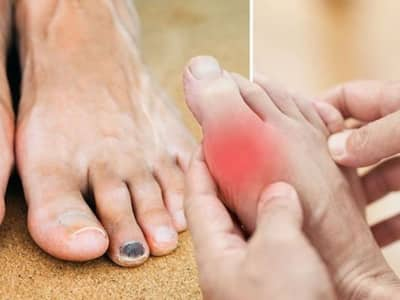
Check out these symptoms of high cholesterol that can show up on your legs and feet.
High cholesterol is often referred to as a ‘silent killer’ because, unlike other health conditions, high cholesterol doesn’t come with a set of signs and symptoms. If left untreated, the presence of high cholesterol in your blood can lead to some severe health complications, that can even land you in the hospital. But before we talk more about cholesterol and its effect on the body, here is what you need to know about this substance that your body produces every day.
Cholesterol is a waxy substance that is found in the blood. It helps in building and making new cells. However, excessive amounts of this waxy substance in the blood can lead to the onset of some severe health conditions such as heart disease, stroke, etc. As per experts, approximately 40 per cent of the total population in India is suffering from underlying cholesterol conditions, and most of them are totally unaware of it. Although it is called a silent killer (no symptoms), there are a few things that can happen to your body when the cholesterol levels are high in your blood. And one of them is changes in your legs and feet.
Signs of High Cholesterol In Legs And Feet
Did you know high cholesterol can be tracked by just looking at your legs and feet? Yes, you read that right. Your legs can feet can show up certain unusual symptoms that can predict the onset of high cholesterol levels in your blood. Scroll down to know more.
High cholesterol can increase your risk of peripheral artery disease, which in turn can cause symptoms to develop in your legs and feet. Here are some of them that can tell you about the onset of high cholesterol in your blood:
Leg Pain
High cholesterol in your blood can lead to the onset of peripheral artery disease that can effectively reduce or even block the blood flow in your limbs (such as your legs and arms). One of the most common signs of this condition is leg pain.
Unusual Cramps
Due to a lack of blood flow in your legs and feet areas, the first thing that can happen is cramps. It can be also listed as the first sign that may appear with low pain when your cholesterol levels are high.
Not Able to Walk Properly
Due to numbness and tingling effects caused by high cholesterol, the patient may find it difficult to walk properly.
Yellow Deposits Near Buttocks
A very unusual sign of high cholesterol is the yellowish-coloured deposits on the skin, that mainly appear near the buttocks.
READ RELATED: 7 Healthiest Chick-fil-A Breakfast Items, According to a Dietitian
Numbness In Legs And Feet
Lack of blood flow to the legs and feet can make the lower portion of the body feel different than usual. You may notice numbness and feel tingling in those areas of your body.
Change In Skin Colour
A person suffering from high cholesterol may notice yellow colour deposits near the back of the lower legs.
Tissue Death
If left untreated, high cholesterol can lead to tissue death. This mainly happens due to the lack of blood flow in those areas of your body. Over time, as arteries narrow down, one may develop pain even when resting or ulcers that just do not heal.
Change In Toenails Colour
One of the signs of high cholesterol can be also noticed on your toenails. You may notice a visible change in its colour. Apart from this, the toenails may also become thickened, or deformed, when the blood cholesterol levels are high in your body.
Cold Feet
If you ever notice cold feet or unusually lower temperatures in your legs, make sure to get your cholesterol levels checked. It can be one of the warning signs that you are suffering from high cholesterol levels.
Leg Sores
When you have high cholesterol levels, your legs may seem a little extra sore than what it looks when everything is normal. Poor blood flow from the arteries to the legs and feet can effectively increase a person’s chances of developing sores called arterial ulcers. These sores can be mainly noticed on the legs, feet, ankles, or toes.
Speaking to TheHealthSite.com about the importance of cholesterol in the body, and why one should keep a check on it, Dr Dhiman Chatterjee, Bele Vue Hospitals, said, “Cholesterol, along with other fats and substances, can form plaque on the walls of your arteries this process is called atherosclerosis. People with high cholesterol are at risk of atherosclerosis, which can narrow the arteries and reduce blood flow to the tissues.” He further added, “This plaque that is formed by the waxy cholesterol can create problems for the blood to flow through the heart, leading to heart attacks, stroke (blood clots in the brain), and atherosclerosis.”
Total Wellness is now just a click away.
Follow us on
window.addEventListener(‘load’, (event) => {
// $(document).ready(function(){
$(‘#commentbtn’).on(“click”,function(){
(function(d, s, id) { var js, fjs = d.getElementsByTagName(s)[0]; if (d.getElementById(id)) return; js = d.createElement(s); js.id = id; js.src = “//connect.facebook.net/en_US/sdk.js#xfbml=1&version=v2.3”; fjs.parentNode.insertBefore(js, fjs);}(document, ‘script’, ‘facebook-jssdk’));
$(“.cmntbox”).toggle();
});
// });
});







